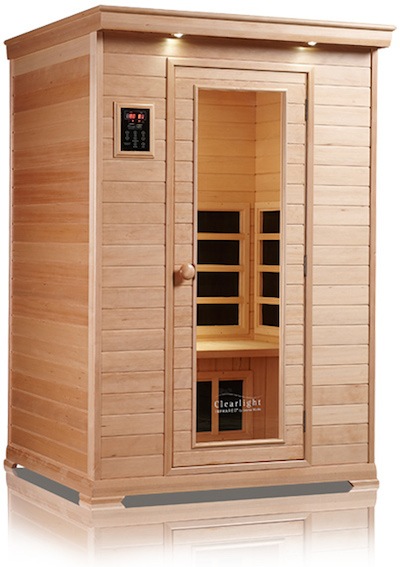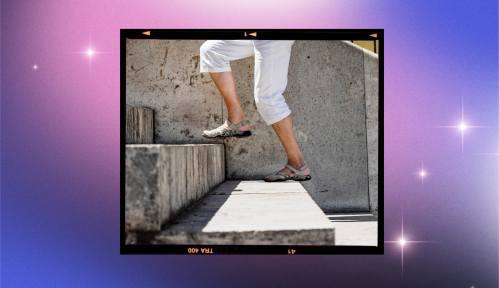Our editors independently select these products. Making a purchase through our links may earn Well+Good a commission
Is far infrared heat really the best form of a sweaty detox?
This trendy way to detox now has studies that show infrared heat therapy can help with pain relief, weight loss, and skin issues. Experts are taking notice.
Lately, when talk turns to detoxing (remember when we used to talk about movies?), many wellness tastemakers have been touting far infrared heat saunas—or pods, or beds—as their preferred instigator of sweat.
Jennifer Aniston swears by it. Selena Gomez’s trainer considers it a world tour must-have. You know Gwyneth has tried it.
But, besides becoming a major topic of conversation, is this form of detox any different than your standard sauna schvitz—or even from the science-backed results you get from a sweaty workout?
Infrared aficionados insist it results in a host of health benefits, from clearer skin to pain relief and weight loss
To put it simply, infrared therapy involves exposing the body to invisible radiant energy. These light rays are longer than visible rays. The big difference from other saunas you may have been in is that far infared saunas, pods, and beds raise your core temperature instead of heating the air around you, causing a crazy-intense sweat (and, supposedly, a crazy-intense detox).
The practice has been a staple in Europe and Asia for years, but besides being offered at a handful of detox spas in New York and Los Angeles, it’s now starting to make a big mark on fitness studios, as well as more wellness centers and doctors’ offices across the U.S.
Infrared aficionados insist it results in a host of health benefits, from clearer skin to pain relief and weight loss—not to mention that it’s said to be a more comfortable experience than you’d get in a traditional sauna. But are the claims legit?
Keep reading to discover everything you need to know about infrared heat, including the science behind it—and whether it’s really worth all the hype.

How infrared heat is linked to detox
Although infrared heat treatments may be a modern invention, sweating as a wellness practice is most most definitely not. “Sweat therapy goes back thousands of years to the Greek and Egyptian cultures,” says Joseph Harounian, founder of Firm Body Evolution, a holistic wellness space that was one of the first in Los Angeles to offer far infrared heat therapy—in pods!—when it opened in 2008. “When someone was really sick, they’d put them in a heated room and just make them sweat like crazy. They understood that they needed to get out whatever was in the body making that person ill.”
Obviously, technology has evolved over the years—the fire pits used in traditional sweat lodges eventually gave way to the electric radiators that heat up the steam rooms and dry heat saunas you typically find in a spa. But while these treatments warm up the body by heating the air around it, far infrared devices use light rays that penetrate the skin cells and heat them from within.
That means people who can’t handle the 200ºF (and above) air temperature of a regular sauna can still reap the benefits—the air temperature in an infrared sauna only goes up to about 120ºF (imagine a summer day in Palm Springs). And according to those in the know, there are a lot of benefits to be had.

What the studies—and detox junkies—say
Some studies have shown that far infrared heat therapy helps lower blood pressure, reduces chronic pain, improves circulation, and boosts mood, while infrared heat junkies swear that it also gives them better skin, helps them sleep, and even assists in weight loss by speeding up the heart rate.
According to naturopathic physician Gabrielle Francis, “You can burn 1,000 calories in a 1-hour infrared heat session; plus, you eliminate excess water retention that is being caused by toxicity.” (She also believes infrared heat helps detox and rid the body of infection, and claims that she has found success in using it as a complimentary treatment for Lyme disease.) Others, like at Higher Dose in New York City, say a natural buzz or feeling of euphoria is a resulting perk; a recent study confirms this. (“Dose” stands for Dopamine, Oxytocin, Serotonin, and Endorphins—happiness chemicals they believe are activated by the process.)
Which treatment’s right for you?

There’s more than one way to get your infrared sweat on, and since there’s no concrete evidence that a single tactic is better than the rest, it all comes down to personal preference.
At Francis’ office in New York, patients put on their swimsuits and sit inside a Clearlight cedar wood infrared sauna, where they relax with music and chromotherapy lights (she says they’re used “for chakra balancing.”) In Los Angeles’ Shape House you’ll don sweats and cuddle up under an infrared heat blanket while watching Netflix.
Fitness studios like Y7 and Poe Yoga in New York and Los Angeles are using infrared heat systems to create super-sweaty classes without the stuffiness that comes with forced air systems.
And at Firm Body Evolution in LA, clients are ensconced in high-tech pods that combine far infrared rays with near infrared light, which is often used in dermatologists’ offices to help repair damaged skin.
No matter which heating modality you choose, says Francis, “It’s important to drink electrolytes before and after using the sauna, like Emergen-C or coconut water.” She adds that if you’re prone to seizures, high blood pressure, or faint easily, this probably isn’t the right treatment for you—and it’s also contraindicated for women who are pregnant, nursing, or trying to become pregnant.

Is it worth it?
A single infrared therapy session generally costs around $50 at a spa or wellness center, while installing an infrared sauna at home (like Jen Aniston reportedly did) will set you back several thousand dollars. And although there has been some scientific research conducted around infrared heat’s benefits, it’s by no means an extensive amount.
But even if you’re not convinced that infrared heat itself is the holy grail of wellness, says Harounian, there’s no question that basking in its rays with no other agenda is seriously relaxing.
And, he adds, “Anything that reduces stress helps so many different conditions—that’s what makes infrared saunas so incredible.” Looks like planks and box jumps aren’t the only path to a good—and good-for-you—sweat.
If you want to try infrared heat therapy for yourself, there are a few things you’ll need to have at the ready—a sweat-proof hairstyle, an arsenal of detox recipes, and a hydrating beverage to sip on (this one‘s less than a dollar).
Sign Up for Our Daily Newsletter
Get all the latest in wellness, trends, food, fitness, beauty, and more delivered right to your inbox.
Got it, you've been added to our email list.










